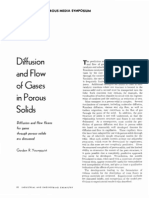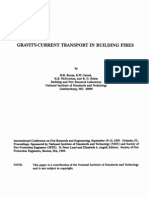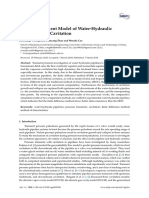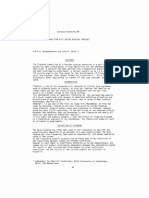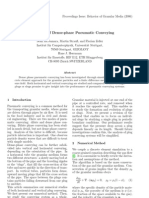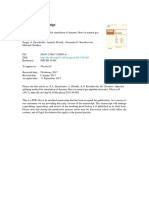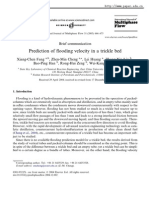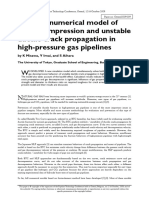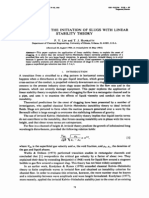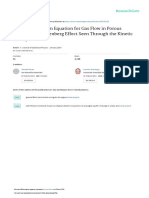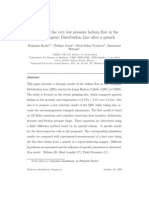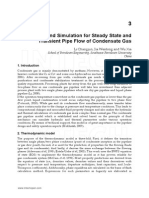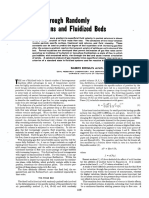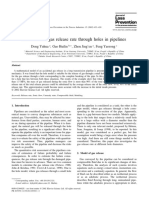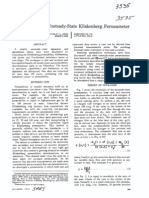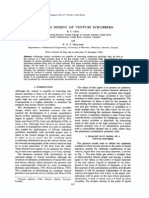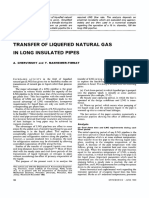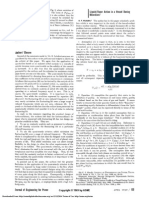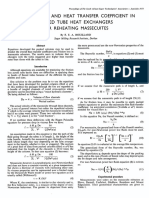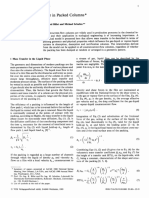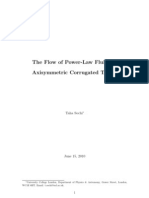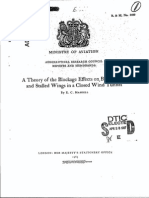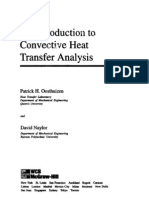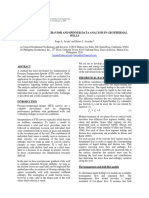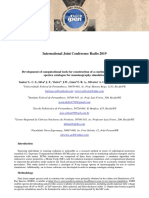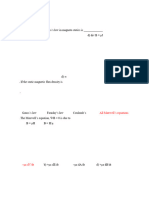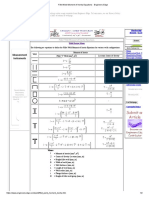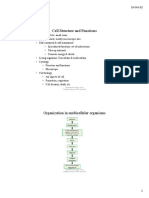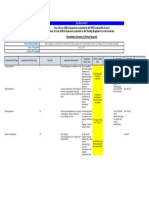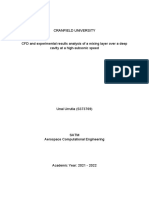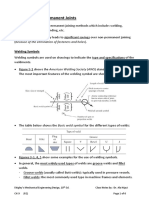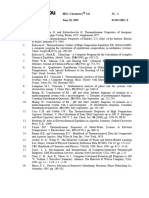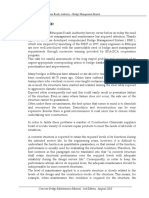This Content Downloaded From 115.27.201.150 On Wed, 03 May 2023 02:50:06 +00:00
This Content Downloaded From 115.27.201.150 On Wed, 03 May 2023 02:50:06 +00:00
Uploaded by
llllllistenyxCopyright:
Available Formats
This Content Downloaded From 115.27.201.150 On Wed, 03 May 2023 02:50:06 +00:00
This Content Downloaded From 115.27.201.150 On Wed, 03 May 2023 02:50:06 +00:00
Uploaded by
llllllistenyxOriginal Title
Copyright
Available Formats
Share this document
Did you find this document useful?
Is this content inappropriate?
Copyright:
Available Formats
This Content Downloaded From 115.27.201.150 On Wed, 03 May 2023 02:50:06 +00:00
This Content Downloaded From 115.27.201.150 On Wed, 03 May 2023 02:50:06 +00:00
Uploaded by
llllllistenyxCopyright:
Available Formats
A Theory of Gas Flow Through Capillary Tubes
Author(s): G. M. Fryer
Source: Proceedings of the Royal Society of London. Series A, Mathematical and
Physical Sciences , Aug. 9, 1966, Vol. 293, No. 1434 (Aug. 9, 1966), pp. 329-341
Published by: Royal Society
Stable URL: http://www.jstor.com/stable/2415472
JSTOR is a not-for-profit service that helps scholars, researchers, and students discover, use, and build upon a wide
range of content in a trusted digital archive. We use information technology and tools to increase productivity and
facilitate new forms of scholarship. For more information about JSTOR, please contact support@jstor.org.
Your use of the JSTOR archive indicates your acceptance of the Terms & Conditions of Use, available at
https://about.jstor.org/terms
Royal Society is collaborating with JSTOR to digitize, preserve and extend access to
Proceedings of the Royal Society of London. Series A, Mathematical and Physical Sciences
This content downloaded from
115.27.201.150 on Wed, 03 May 2023 02:50:06 +00:00
All use subject to https://about.jstor.org/terms
A theory of gas flow through capillary tubes
BY G. M. FRYER
Houldsworth School of Applied Science, University of Leeds
(Communicated by R. M. Barrer, F.R.S.-Received 22 July 1965
-Revised 3 May 1966)
A single equation for gas flow through capillaries, applicable to the flow regimes extending
from molecular to viscous flow, is derived by formulating corrections to the Poiseuille equa-
tion for viscous flow. These correction terms are necessary to allow for transmission to the
tube wvall of the momentum generated by the pressure gradient. It is shown that the equation
agrees closely with experimental observation, reducing to Knudsen's equation for molecular
flow as the pressure tends to zero. In the appendix an argument is put forward to explain the
variation among experimental measurements of the slip coefficient.
1. INTRODUCTION
Previously, the theory of gas flow through capillary tubes has been treated satis-
factorily only in two distinct and separated pressure regions. These are (a) at low
pressures where the mean free path of the gas molecules is large compared with the
capillary diameter, and (b) at moderate pressures where the mean free path of the
gas molecules is much smaller than the capillary diameter, but where the pressure
is not high enough for the flow to be turbulent.
The theory of 'molecular flow' in the low pressure region was formulated, by
different methods, by Knudsen (I909) and by Smoluchowski (i9io), both of whom
derived the equation 32XT idp
Q = -a3 1(M)dI ? 'I(I)
where the amount Q of gas flowing in unit time is measured in pressure x volume
units, a is the capillary radius, R is the gas constant per gram molecule, T is the
absolute temperature, ]MI is the molecular weight of the gas and dp/dx is the axial
pressure gradient within the tube.
In the moderate pressure region the gas flows viscously, and the usual theoretical
analysis leads to an equation representing Poiseuille flow, together with an incre-
mental flow due to 'slip' at the wall of the tube (Kundt & Warburg 1875; Maxwell
I879). This equation is
E7Ta4 dp +gan (2-f 21TRTj dp (2)
where i is the coefficient of viscosity of the gas, p
the pressure gradient is dp/dx, andf is a quantity introduced by Maxwell, which he
defined as the average fraction of the tangential momentum of a molecule trans-
ferred to the wall of the tube on collision.
It is clear that (2) does not reduce to (1) as the pressure tends to zero, although it
may be made to do so by the introduction of a variable factor multiplying the
second term in (2), having the value unity for viscous flow and 16/3nT(2 -f) fo
[ 329
This content downloaded from
115.27.201.150 on Wed, 03 May 2023 02:50:06 +00:00
All use subject to https://about.jstor.org/terms
330 G. M. Fryer
molecular flow (Carman 1956). However, experimental observations have shown
that this factor does not vary uniformly in the transition region where the mean free
path of the gas molecules is comparable with the capillary diameter: experiments
by Knudsen (I909) showed that the ratio Q,/Ap (where Ap is the pressure dif
across the tube) can have a minimum value in this region.
Knudsen proposed a semi-empirical equation to describe his experimental results
at all pressures
Q = b b(aiiii b1 +clp Ap, (3)
+CP1 + C2Pj
where - is the mean gas pressure, a, b1, cl and c2 are constants, and where Xp < p.
Knudsen's equation for molecular flow at low pressures (1) did not agree exactly
with his experimental results, but this was undoubtedly because of the presence of
mercury vapour in the apparatus: Gaede (I 913) repeated Knudsen's experiments at
very low pressures, while taking care to freeze out any mercury vapour, and showed
that (1) was indeed applicable.
In the present paper a single gas flow equation for molecular flow, viscous flow
and the transition region between them will be deduced by making various modifica-
tions to the derivation of (2) for viscous flow with slip. It will be shown that there is
close agreement between the predictions of the resulting equation and Knudsen's
experimental observations.
2. THE PRELIMINARY VISCOUS FLOW EQUATION
The starting point is the usual concept that the viscous flow of gas through a
cylindrical capillary tube, of which the length is large compared with the diameter,
consists of Poiseuille flow with an increment due to slip at the wall of the tube.
Following Kundt & Warburg, we assume that the slip velocity will be proportional
to the gradient of gas flow velocity near the wall.
If v is the varying component of gas flow velocity and dv/dr its gradient, the
velocity of the slip relative to the wall will then be
u = - dv/dr, (4)
where C is the 'coefficient of slip'. The slip velocity is necessary to permit all the
momentum generated by the pressure gradient to be transmitted to the wall of the
tube: this concept will be examined in detail in the appendix.
The conventional treatment for Poiseuille flow with slip in a cylindrical tube
(Kennard 1938, pp. 292-4) leads to the equation
ira4 41+& d2
Q 88 P ( + a) dp (5)
In this equation the first term represents Poiseuille flow, while the second represents
the additional flow due to slip. C may be evaluated from gas flow experiments at
moderately high pressures by plotting the ratio Q/(dp/dx) against p, and deter-
mining the intercept at p = 0 of the straight line so obtained. Knudsen's results
indicate that C-43A, where A is the mean free path of the gas molecules.
This content downloaded from
115.27.201.150 on Wed, 03 May 2023 02:50:06 +00:00
All use subject to https://about.jstor.org/terms
A theory of gas flow through capillary tubes 331
The theoretical evaluation of the slip coefficient will be discussed in the appendix,
but for the present treatment the above value will be assumed correct. Substituting
this value in (5) one obtains
ga 4P 1?6A) dp
Q 8r( 3 a dx (6)
To obtain an equation entirely in terms of pressure, we can define
Pi = Ap/2a,
i.e. Pi is that pressure at which the mean free path of the gas molecules equals the
capillary diameter. Since, in addition, _12pcA, where p is the density of the g
and c is its mean molecular velocity, it is easily shown that
rTa4p 1T a3 27TRT W p
sr 32 ] Pi
Equation (6) may therefore be rewritten
Q - a3 (2T) _~~ p (7)
0~ ~ ~ =a (X)(32 p +3)
3. CORRECTIONS TO THE PRELIMINARY EQUATION
Equations (6) and (7) are identical in form to (2), and like (2) they do not of course
reduce to (1) asp tends to zero, and do not explain the observed minimum in the plot
of Q/(dp/dx) against p. The basic premise involved in the derivation of a gas flow
equation is that all the flow momentum generated by the pressure gradient must be
transmitted to the wall of the tube, and certain modifications must be made to (7)
to ensure that this condition is rigorously obeyed.
3- 1. Correction of the 'slip ' term
Equation (7) implies that, in addition to the velocity indicated by Poiseuille flow,
every molecule will possess an additional average flow velocity represented by the
slip flow term. The slip term as it stands must be incomplete, since it must vanish as
p - 0 (when only molecular flow exists). Weber (I954) showed that slip flow still
exists at very low pressures when only isolated inter-molecular collisions occur,
when it arises because a molecule involved in such a collision is more likely to be
struck by a second molecule coming from upstream than by one coming from down-
stream, and so will, on average, acquire an additional flow momentum. For this
reason molecules whose last collision was at the wall can have no slip velocity (it
being assumed for the present that such molecules are diffusely reflected with no
average flow velocity).
The fraction of such molecules present at any pressure p may be evaluated as
follows. If the gas is Maxwellian, the total number of wall collisions per unit length
of tube in unit time is ln-c2Ia, where n is the number of molecules in unit volume.
The total number of intermolecular collisions in unit length of tube in unit time is
lTa2nc/A. Hence the proportion of molecules at any instant whose last collision was
at the wall is gj7anc P
_P7anc + gra2nc/A p +Pi
This content downloaded from
115.27.201.150 on Wed, 03 May 2023 02:50:06 +00:00
All use subject to https://about.jstor.org/terms
332 G. M. Fryer
The remaining mnolecules (f
calculated slip velocity, and so (7) may be rewritten
3 2/iRBT\ irp ir p \dp(8
Q =- kMM ) p3P+3+ld
1 Pi3 p dx' (S)
3-2. Molecular diffusion near the wall
In obtaining (8) it has been assumed that molecules which have just been reflected
from the wall possess no average flow momentum. This is not strictly true since,
although molecules are diffusely reflected, more are reflected from a given element of
wall surface at high pressure than from a similar element at low pressure, so that
there must be an effective flow of these molecules down the pressure gradient (just
as there is in pure molecular flow). Since these molecules move only with their
Maxwellian velocities until such time as they are reabsorbed into the viscous stream,
any hypothetical flow velocity we allot to a given molecule will be expected to be
a component of its molecular velocity c.
In a Maxwellian gas with n molecules in unit volume, the number dn with velocity
between c and c + dc is given by the Maxwell distribution law
4n (c2\
dn - - 1c2exp --2- dc,
where a is the most probable speed. The nurnber of these molecules emitted from
unit area of tube wall per second is 4c dn. If o is the flow velocity attributed to these
molecules, and m is the molecular mass, then the flow momentum carried by these
molecules is lcm& dn. The molecules move only with their Maxwellian velocities,
so that one may write = kc, where k is a constant of proportionality;
the flow nmomentum carried by the molecules under consideration is therefore
Ikc2m dn.
The total momentum in the direction of flow carried by all molecules leaving unit
area of wall surface per second is therefore
B1k4m " 4 c
4 7T Jo 23 ( 2\
- 1nkmcm-2
4 2
or, since 2=a/T-L
B- -Trnmkc 2.
Now kc = Ew/n v=r, where vr is the arithmetic mean of the flow velocities of a
the reflected molecules, and so
B 7m32rrnmcv,
If we consider unit length of tube the momentum acquired by these molecules
per second is
332
27Tanm-iv
vr
This content downloaded from
115.27.201.150 on Wed, 03 May 2023 02:50:06 +00:00
All use subject to https://about.jstor.org/terms
A theory of gas flow through capillary tubes 333
This momelitum is derived from the partial pressure gradient of the molecules whose
last collision was at the tube wall, and so
37T2 2 p]_ dp
6 ap6v. =-ra2 Pi dp
16 a + P?Pi dx'
whence v,- 1a (Pi31Tp-5\+i
VT- dp dx'
Co pc +P1 d
Since reflected molecules can be regarded as having a flow velocity vr when they
rejoin the viscous stream, it is necessary to add the same velocity vr to the slip
velocity of the viscously flowing gas, since otherwise the decrease in the flow velocity
of molecules between leaving the viscous stream and rejoining it after reflexion at
the tube wall will not be sufficient to account for the transmission to the wall of the
whole of the momentum generated by the pressure gradient. This means that all the
molecules flowing through the tube, whether they have just been reflected or not,
must be allotted an additional flow velocity Vr. This results in an additional gas flow
term which, in pressure x volume units, is
-7Ta2pv,. = PIP 16 a dp
P+P1 37Tpc dx
___ I2iRT\ p dp I 2RT\
= 3 4 )P _p dx (since-c = 2 2
This must be inserted in (8) to give the corrected viscous flow equation
3/2iRT\ /lTp g p 4 pi \dp
( M )(32pi 3p+pl 3p+pi_ dx(
This equationl has the same form as Knudsen's empirical equation (3) and was first
suggested, although not rigorously derived, by Weber (1954). Weber interpreted
the molecular flow term
_ f27RTR T P dp
"l3
P !\P Pipd
IMj +Pi dx
as being representative of a 'self-diffusion' down the pressure gradie
within the viscously flowing layers of gas, and indeed the same term ma
by attributing a self-diffusion coefficient '-CA to all those mo
p/(p +pi)) which possess a slip velocity in the viscous stream. Howe
assumed in the foregoing treatment that the flow velocity of molecules at any
position in the tube is governed entirely by the way in which the momentum
generated by the pressure gradient is transmitted towards the wall, and it is diffic
to justify an additional flow velocity which is not governed by this rule. In any case
it is known that a diffusion coefficient 1-CA is inaccurate even for the simplest case of
molecules approximating to hard, elastic spheres, when a coefficient 0- 60 -cA should
be used (Kennard I938, p. 195).
This content downloaded from
115.27.201.150 on Wed, 03 May 2023 02:50:06 +00:00
All use subject to https://about.jstor.org/terms
334 G. M. Fryer
4. THE VARIATION OF (9) WITH PRESSURE
The three terms in (9) represent Poiseuille flow, slip flow and molecular flow
respectively. At high pressures (p > Pi) it becomes the usual uncorrected viscous flow
equation (7) and at very low pressures (p <p1) it becomes Knudsen's molecular
flow equation (1). Equation (9) as it stands shows a minimum value of Q/(dp/dx)
when this ratio is plotted against pressure, but the minimum value of the ratio is too
high when compared with Knudsen's experimental observations. This suggests that
(9), deduced as it is for relatively high pressures, is not entirely correct at low
pressures, and so let us consider what may happen to each term as the pressure is
reduced.
The molecular flow term
'327TRT\2P dp
3 M ) P+pl dx
cannot be expected to alter as the pressure is reduced, since its mathematical deriva-
tion is identical at all pressures. When p <?Pi this term turns naturally into
Knudsen's molecular flow equation (1).
The slip flow term
T 3 {27STT p dp
3 M Il / +Pi dx
has (except for the factor p/(p +p1)) been derived as a correction to Poiseuille flow.
Weber's calculation of the slip flow which exists at very low pressures, when viscous
streaming is negligible, leads to the slip flow term
7 a3 /2 7T R T -,1 p dp
3 M l Pi dx
which is clearly the low-pressure limit of the slip term in (9). It is therefore reason-
able to assume that the term applies equally at all pressures. The numerical factor
in Weber's low-pressure slip term lends support to the value of the slip coefficient
adopted earlier ( = 4A). The correction factor p/(p ?p1) has been deduced from a
knowledge of the physical meaning of slip flow at low pressures. The correction may
require modification at pressures where viscous flow becomes significant, but it is
reasonable to adopt this low pressure value because it is at low pressures that the
slip flow correction has the greatest effect on the total gas flow.
* The Poiseuille flow term
r 3 27TrRT 2 p dp
32 M p dx
is proportional to p2 in its integrated form, and at very low pressures it is probably
best regarded as being proportional to the probability that a molecule coming from
an intermolecular collision will suffer a further intermolecular collision before it
reaches the wall. However, at very low pressures it is inaccurate to assume that all
molecules are available for collision, since as the pressure is reduced an increasing
proportion of molecules are engaged on wall-to-wall paths, and it is inconceivable
that such molecules can in any way contribute to viscous flow.
This content downloaded from
115.27.201.150 on Wed, 03 May 2023 02:50:06 +00:00
All use subject to https://about.jstor.org/terms
A theory of ga8 flow through capillary tube8 335
If the fraction of molecules engaged on wall-to-wall paths isf(p), we must subtract
from (9) a final correction term
-3T a3 (27RT M f) dp
32 x Pi dx
An accurate value of f(p) is difficult to deduce because of the indefinite integrals
involved, but Scott & Dullien (i962) suggested that
f(p) = exp (- sinh-'(p/pL))
was a good approximation. (This is not a solution of the integrals involved, but was
chosen as a function which approximated closely to a series of numerical solutions.)
At low pressures this approximates to exp (-p/p1), which is the proportion of
molecules which in unconstricted space would possess a free path greater than 2a.
This is fully expected, since the true mean free path of molecules diffusing through
a tube at very low pressures can be shown to be 2a.
3 -
CI
-0
O2~~~~~I- _o- 0
iL 1
p (cmHg)
FIGURE 1. Knudsen's observations ( o ), tube 4 with carbon dioxide,
compared with equation (10) (-).
After making this final correction to (9), one obtains
Q a 2 R P [1-exp (-sinh lP ) + p + (1 30 P)d
This equation can be checked against Knudsen's experimental observations without
modification, since the experimental conditions were such that dp/dx can be replace
by iXp/l, where 1 is the capillary length, and also p can be replaced by -, the mean
gas pressure. In figures 1 and 2 gas flow curves calculated from (10) are compared
with Knudsen's results for carbon dioxide and oxygen with his 'tube 4'. This
This content downloaded from
115.27.201.150 on Wed, 03 May 2023 02:50:06 +00:00
All use subject to https://about.jstor.org/terms
336 G. M. Fryer
'tube 4' actually consisted of 24 tubes in parallel, each of which possessed a bore
radius 0 00333 cm. This is considerably smaller than for any of his other tubes, and
the transition region in the curve of Q/iXp occurs at a pressure well above the
pressure range where the presence of mercury vapour can have any appreciable
effect. This is not so for Knudsen's other tubes. In addition the flow rate through
'tube 4' was sufficiently slow for pressure measurements to be made accurately.
It can be seel from figures 1 and 2 that the agreement between (10) and Knudsen's
observations is very close, suggesting that the equation is valid at all pressures up to
that at which turbulence begins.
4-
r2
-2 10 10
p (cmHg)
FIGURE 2. Knudsen's observations (o), tube 4 with oxygen,
compared with equation (10) ().
APPENDIX. THE SLIP COEFFICIENT
In the foregoing theory the adopted value of the slip coefficient C was 43A, partly
because this value was indicated by Knudsen's readings at moderately high pres-
sures (not shown in figures 1 and 2) and partly because the slip flow term in (10)
agreed with that calculated by Weber (1954) for flow at very low pressures. How-
ever, no attempt was made to calculate a theoretical value of C and this problem will
be examined in the following pages.
As far as the author knows, the only attempt to calculate C on the basis of ele-
mentary kinetic theory was made by Maxwell (1879), and his reasoning may be
stated simply as follows. Consider a gas flowing over a plane surface with a flow
velocity v which varies in a direction perpendicular to the surface. Let the direction
of flow be that of the y axis and the direction of variation that of the z axis, and let
the fixed surface be at z = 0. The velocity gradient is assumed to be uniform above
This content downloaded from
115.27.201.150 on Wed, 03 May 2023 02:50:06 +00:00
All use subject to https://about.jstor.org/terms
A theory of gas flow through capillary tubes 337
a certain value of z, so that the 'slip velocity ' u is obtained by extending the uniform
velocity profile to z = 0 (figure 3).
Maxwell suggested that the molecules near the surface will consist of two streams,
those approaching the surface and those which have just struck it, the viscous drag
at the surface being the difference between the tangential momentum brought up
by the approaching stream and that carried away by the receding one in unit time.
X /
FIGURE 3. The Maxwell model for the velocity profile of a gas flowing over
a plane surface at z = 0.
Maxwell assumed that on striking the surface the niolecules give to it, on average,
a fraction f of their tangential momentum. If the approaching stream is similar in
character to a corresponding stream in the midst of the gas, then, relative to a frame
of reference moving with velocity u, an amount of momentum IV dv/dz will be
brought up to unit area of the surface per second. To this must be added the
momentum due to the slip velocity u, of amount 4pCl. Equating momentumn
up tJo the surface with that transmitted across parallel planes in the gas, we have
1 dv ~dv
f (2J2dz+Pfl
Z + 41 pC?I) =dz
II
and since X -dv/dz and lp-cA, we obtain
A(2-f)/f.
If this is correct, then our value C = 4A, for oxygen and carbon dioxide with glass,
implies that on average 14-3 %0 of incident molecules are specularly reflected. This is
unsatisfactory, since Smoluchowski's equation for molecular flow at low pressures
(1) was rigorously derived on the assumption that all molecules were diffusely
reflected from the wall of the tube, and there is no reason to suppose that the mode
of reflexion will be any different at high pressures. For this reason one must look for
some alternative to Maxwell's relation.
The only satisfactory way to determine the true slip coefficient is to determine
the true shape of the velocity profile: this has been attempted and the new model
velocity profile is depicted in figure 4 (curve B).
The prerequisite of any model velocity profile is that its value at z = 0 shall be
A(dv/dz)g, where (dv/dz)g is the velocity gradient in the midst of the gas away from
the fixed surface. This is because the rate of momentum transfer towards the fixed
This content downloaded from
115.27.201.150 on Wed, 03 May 2023 02:50:06 +00:00
All use subject to https://about.jstor.org/terms
338 G. M. Fryer
surface (per unit area perpen
average flow velocity of mol
(since lp62A(dv/dz)g y I (dv/
diffusely reflected from the fixed surface with zero flow velocity, it follows that the
average flow velocity near the surface must be A(dv/dz)g.
6/
S/
2- A/
43 /
O 1 2 3 4 5
ZIA
FIGURE 4. Model velocity profile for gas flow over a smooth plane surface at z 0.
As a first step towards calculating the profile in figure 4 the gas was considered as
a series of layers, each lying perpendicular to the direction of z and each of thickness
0-2A. The flow velocity at any value of z is the average of the flow velocities of all
molecules arriving at that position from both higher and lower values of z. By
graphical integration, the fraction of these incident molecules coming from each of
the layers of thickness 0-2A was determined (the fractions become negligible at
distances greater than ca. 4A).
It is easily shown that the molecules arriving at a given layer of gas have travelled,
on average, a distance 2A in the direction of z since their last collision, and if the
coefficient of viscosity is calculated on the assumption that the flow velocity of any
molecule equals that of the gas at the position of its last collision, '= -pCA is
obtained. However, the true value of y -A, which implies that molecules
arriving at a specified gas layer carry an average flow momentum typical not of the
layer of gas from which they have just come but of a layer -?A more distant. The
major cause of this effect is the persistence of velocity of a molecule on collision,
This content downloaded from
115.27.201.150 on Wed, 03 May 2023 02:50:06 +00:00
All use subject to https://about.jstor.org/terms
A theory of gas flow through capillary tubes 339
and to allow for this in the present model it was assumed that any given molecule
originated in a layer of gas 3A more distant than that originally computed. The
model involves some slight inaccuracy, since it makes no rigorous allowance for the
fact that long free paths are more likely to be described by high-velocity molecules
(which possess a persistence of velocity greater than the average), nor for the
variation in collision rate with the length of free path, caused by the variation in
the flow velocity of the gas through which the molecule is passing.
TABLE 1. EXPERIMENTAL EVALUATIONS OF THE SLIP COEFFICIENT C
1. Knudsen (I909) method: capillary flow (
CO2 and 02, glass 1 33
2. Millikan (1923) method: deviation from Stokes's
law for falling droplets
air, watch oil 1-20
H2, watch oil 1 16
air, mercury 101
air, shellac 1-53
3. Stacey (I923) method: rotating cylinder
air, machined brass 1 00 + 0 05
(2 days 145
2 days 1P33
air, shellac, after 4 days 1 27
10 days 1P12
2 months 102+004
4. Van Dyke (I923) method: rotating cylinder
air, watch oil 1-24 + 0-05
C029 watch oil 1416 ? 0 01
air, scratched brass 1 10 + 0 03
Co2, scratched brass 0 97 + 0-04
air, old shellac 1 03 + 0 03
C02, old shellac 1P03 + 0 05
Once the distribution of flow velocities of all molecules arriving at a given layer
of gas had been calculated, the model velocity profile shown in figure 4 (curve B)
was determined by a method involving successive graphical approximations. This
velocity profile is the only one possible which tends to a velocity A(dv/dz)g at z =
and for which the velocity at any value of z equals the average velocity of all mole-
cules arriving at that position (within the limitations of the model). It is seen that a
slip velocity !A(dv/dz)g is accurately predicted, so that there is no necessity to
assume that molecules reflected at a smooth surface suffer partial specular reflexion.
Some experimental evaluations of the slip coefficient with various gases and
surfaces are given in table 1. In this table the uncertainties represent the range of
results obtained when a number of readings were taken; it would probably be
reasonable to allow a possible error of about + 0 04A in each of the results obtained
by Stacey (1923) and van Dyke (1923).
It is seen that shellac surfaces exhibit a high slip coefficient when fresh, but that
this decreases with age until C _ A, as for machined brass. The change in the surface
is probably due to oxidation, causing increasing roughness. Although C> 4A for
22 VOl. 293. A.
This content downloaded from
115.27.201.150 on Wed, 03 May 2023 02:50:06 +00:00
All use subject to https://about.jstor.org/terms
340 G. M. Fryer
fresh shellac, it is possible that evaporating solvents cause a layer of decreased
viscosity near the surface. The observation that surface roughness can cause a
reduction in the value of the slip coefficient until C A has been taken to in
that the proportion of molecules specularly reflected must decrease as the degree of
roughness increased. Since, on the basis of the model put forward in this appendix,
there is no reason to suppose that any specular reflexion occurs at a smooth surface,
one must look for an alternative explanation.
If C 4A for diffuse reflexion at a smooth surface, a decrease of C to C A at a
very rough surface implies that the rate of transfer of flow momeintum to such a
surface is even greater than can occur with diffuse reflexion, and it is suggested that
this can occur as a result of 'back reflexion'. A projection on the rough surface will
be struck by more incoming molecules on its upstream side than on its downstream
side, and since each part of the projection can be expected to re-emit only the number
of molecules it receives, there must necessarily be a net re-emission of molecules in a
direction against the gas flow. For C to be reduced to A, some one-fifth of the flow
momentum brought up to the surface by incident molecules would need to be
re-emitted against the gas flow.
A rough calculation by the author, in which it was assumed that molecules would
be re-emitted from the surface in any given direction at a rate equal to that with
which they approached from that direction, suggested that the flow momentum
re-emitted against the gas stream would be about one quarter that received from
incident molecules. Since the assumptions involved in the calculation would be
expected to result in an overestimation of the effect, this result may be considered
to confirm that 'back reflexion' is sufficient to cause the observed variations in the
value of ~.
A similar effect of 'back reflexion' has been observed for low pressure molecular
flow through short tubes by Davis, Levenson & Milleron (i964). The internal
surfaces of their tubes were machined with threads of various geometrical profiles,
and the observed reduction in gas flow through such tubes was of an amount which
could be in agreement with the above model.
It is seen that the treatment of the slip coefficient put forward in this appendix
is easier to correlate with experimental observations than is Maxwell's evaluation.
The arguments put forward relate only to a simple gas that is diffusely reflected,
and says nothing about observed variations of C from gas to gas (Barrer & Nicholson
I965).
Now that a model gas flow velocity profile is available (figure 4) it is possible to
make a direct estimation of the correction to slip flow required at high pressures. The
straight line A in figure 4 represents the velocity profile which is assumed to exist
in the derivation of the preliminary gas flow equation (7) at high pressures where
A < a. The required correction to the slip flow term may be determined directly
by measuring the area between curves A and B. This area is ca. 077A2(dv/dz)g, so
that the amount of gas flow (in pressure x volume units) which must be subtracted
from (7) is
2irap(077A2(dv/dz)g) = -077na2( 2YRT ) lp1dp
This content downloaded from
115.27.201.150 on Wed, 03 May 2023 02:50:06 +00:00
All use subject to https://about.jstor.org/terms
A theory of gas flow through capillary tubes 341
The correction term applied in ? 3d1 was
2T ('21TBT' - Pi dp
3 M P +pp1 dx'
so that it appears that the correction applicable at high pressures is more than twice
that assumed. No allowance for this is made in equation (10), but the slip term
correction made in ? 3d1 must be correct at low pressures (where its influence on the
total gas flow is greatest) since it agrees with Weber's rigorous calculations, and it is
relatively unimportant that the correction should be less accurate at high pressures,
since it is then negligibly small compared with the total amount of gas flow due to
slip.
Thanks are due to the Ministry of Aviation for supporting this work, and to
Professor R. M. Barrer, F.R.S. and Dr D. Nicholson (Imperial College, London) for
helpful discussions.
REFERENCES
Barrer, R. M. & Nicholson, D. I965 Canad. J. Chem. 43, 896.
Carman, P. C. 1956 Flow of gases through porous media. London: Butterworth.
Davis, D. H., Levenson, L. L. & Milleron, N. I964 J. Appl. Phys. 35, 529.
Gaede, W. 1913 Annln Phys. 41, 289.
Kennard, E. H. 1938 Kinetic theory of gases. New York: McGraw-Hill.
Knudsen, M. I909 Annln Phys. 28, 75.
Kundt, A. & Warburg, E. I875 Annln Phys. 155, 337.
Maxwell, J. C. I879 Phil. Trans. 170, 231.
Millikan, R. A. I923 Phys. Rev. 21, 217.
Scott, D. S. & Dullien, F. A. L. I962 A.E.Ch.E.J. 8, 293.
Smoluchowski, M. v. I9IO Annln Phys. 33, 1559.
Stacey, L. J. 1923 Phys. Rev. 21, 239.
Van Dyke, K. S. I923 Phys. Rev. 21, 250.
Weber, S. 1954 Mat.-Fys. Medd. 28 (2).
22-2
This content downloaded from
115.27.201.150 on Wed, 03 May 2023 02:50:06 +00:00
All use subject to https://about.jstor.org/terms
You might also like
- Transport Properties of The Gas (Physical Chemistry 2)Document29 pagesTransport Properties of The Gas (Physical Chemistry 2)Adilla Rizka Yonita100% (1)
- 2.1 Introduction To Timber DesignDocument66 pages2.1 Introduction To Timber DesignNazihahNo ratings yet
- Morris Slip PRA 2002Document3 pagesMorris Slip PRA 2002Michael DetoniNo ratings yet
- Onset of Slugging in Horizontal Gas-Liquid Pipe Flow Bendiksen1992Document11 pagesOnset of Slugging in Horizontal Gas-Liquid Pipe Flow Bendiksen1992chunyuganlinNo ratings yet
- Diffusion and Flow of Gases in Porous SolidsDocument12 pagesDiffusion and Flow of Gases in Porous SolidsSal HashemifardNo ratings yet
- A Simplified Model For Real Gas Expansion Between Two Reservoirs Connected by A Thin TubeDocument14 pagesA Simplified Model For Real Gas Expansion Between Two Reservoirs Connected by A Thin TubeSatyanarayan SahooNo ratings yet
- (1987) A Perturbation Solution For Compressible Viscous Channel FlowDocument18 pages(1987) A Perturbation Solution For Compressible Viscous Channel FlowJing-Wu DongNo ratings yet
- Helfrich 1969Document3 pagesHelfrich 1969Mohammad KhoshantashNo ratings yet
- Numerical Modelling of Subcritical Open Channel Flow Using The K-E Turbulence Model and The Penalty Function Finite Element TechniqueDocument7 pagesNumerical Modelling of Subcritical Open Channel Flow Using The K-E Turbulence Model and The Penalty Function Finite Element TechniquechrissbansNo ratings yet
- Steam Hammer - TheoryDocument6 pagesSteam Hammer - TheoryktsnlNo ratings yet
- Gravity-Current Transport in Building FiresDocument7 pagesGravity-Current Transport in Building Firesreader1900No ratings yet
- Pressure Transient Model of Water-Hydraulic Pipelines With CavitationDocument14 pagesPressure Transient Model of Water-Hydraulic Pipelines With Cavitationjayant pathakNo ratings yet
- THE FLOODING TRANSITION WITH GASSED RUSHTON TURBINES - 1984 - Fluid Mixing IIDocument9 pagesTHE FLOODING TRANSITION WITH GASSED RUSHTON TURBINES - 1984 - Fluid Mixing IIvane-16No ratings yet
- Simulations of Dense-Phase Pneumatic ConveyingDocument7 pagesSimulations of Dense-Phase Pneumatic ConveyingMadan YadavNo ratings yet
- Accepted ManuscriptDocument27 pagesAccepted ManuscriptCarlos AlviarezNo ratings yet
- Flow Pattern Transition For Vertical Two Phase FlowDocument4 pagesFlow Pattern Transition For Vertical Two Phase FlowManojNo ratings yet
- Prediction of Flooding Velocity in A Trickle BedDocument8 pagesPrediction of Flooding Velocity in A Trickle BedMichał KisielewskiNo ratings yet
- 009misawa - Edited - NEWDocument11 pages009misawa - Edited - NEWFilip Van den AbeeleNo ratings yet
- Methods: Full Size ImageDocument6 pagesMethods: Full Size ImageArronNo ratings yet
- Pergamon: Int. J. Multiphase Flow Vol. 20, No. 4, Pp. 739-752, 1994Document14 pagesPergamon: Int. J. Multiphase Flow Vol. 20, No. 4, Pp. 739-752, 1994anellbmcNo ratings yet
- On The Dispersion of A Solute in A Fluid Flowing Through A TubeDocument11 pagesOn The Dispersion of A Solute in A Fluid Flowing Through A TubeCoraKiriNo ratings yet
- Lin e Hanratty 1986 Prediction PDFDocument20 pagesLin e Hanratty 1986 Prediction PDFFrancisco OppsNo ratings yet
- Venturi Scrubbers Pressure Drop and RegainDocument6 pagesVenturi Scrubbers Pressure Drop and RegainMohamed Irfan Z HNo ratings yet
- Plastic Pipes XV Paper Cover Blow OffDocument10 pagesPlastic Pipes XV Paper Cover Blow Offmohannad eliassNo ratings yet
- Modeling of A DC Plasma Torch in Laminar and Turbulent FlowDocument24 pagesModeling of A DC Plasma Torch in Laminar and Turbulent FlowVerayoot1357No ratings yet
- Fluids 04 00095Document15 pagesFluids 04 00095Precious OluwadahunsiNo ratings yet
- Investigation of A Mixing Length and A Two-Equation Turbulence Model Utilizing The Finite Element MethodDocument6 pagesInvestigation of A Mixing Length and A Two-Equation Turbulence Model Utilizing The Finite Element MethodchrissbansNo ratings yet
- LS89 LesDocument16 pagesLS89 Lesmustafasanli2000No ratings yet
- Klinkenberg JOSSDocument36 pagesKlinkenberg JOSSsaurabh6456No ratings yet
- Introduction To Turbulent FlowsDocument12 pagesIntroduction To Turbulent FlowsOmer Ghassan Abdulkareem Hassan AlsultanNo ratings yet
- Wet Wall AbsorptionDocument11 pagesWet Wall Absorptionhagt813No ratings yet
- Numerical Study of Gas-Solid Flow in A Cyclone Separator: B. Wang, D. L. Xu, G. X. Xiao, K. W. Chu and A. B. YUDocument6 pagesNumerical Study of Gas-Solid Flow in A Cyclone Separator: B. Wang, D. L. Xu, G. X. Xiao, K. W. Chu and A. B. YUAzharuddin Ehtesham FarooquiNo ratings yet
- Viscous Diss Tern in Energy EquationsDocument14 pagesViscous Diss Tern in Energy EquationsJohn Jonnalagadda100% (1)
- 09 Simu QRL PDFDocument24 pages09 Simu QRL PDFAli AHNo ratings yet
- The Reynolds AnalogyDocument4 pagesThe Reynolds AnalogyBhawani Pratap Singh PanwarNo ratings yet
- Exhaust Silencer Using Water InjectionDocument10 pagesExhaust Silencer Using Water InjectionLê Vy mạcNo ratings yet
- Modeling and Simulation For Steady State and Transient Pipe FlowDocument21 pagesModeling and Simulation For Steady State and Transient Pipe Flowace4200No ratings yet
- HES5340 Fluid Mechanics 2, Lab 2 - COMPRESSIBLE FLOW (Converging-Diverging Duct Test) (Semester 2, 2012) by Stephen, P. Y. BongDocument26 pagesHES5340 Fluid Mechanics 2, Lab 2 - COMPRESSIBLE FLOW (Converging-Diverging Duct Test) (Semester 2, 2012) by Stephen, P. Y. BongStephenPYBong63% (8)
- Prediction Turbulent in Curved Pipes: by S. V. Patankar, V. S. Pratap B. SpaldingDocument13 pagesPrediction Turbulent in Curved Pipes: by S. V. Patankar, V. S. Pratap B. SpaldingAhmed S. El DenNo ratings yet
- Kernforschungszentrum Karlsruhe, Institute of Nuclear Reactor Components, Karlsruhe, Fed. Rep. GermanyDocument7 pagesKernforschungszentrum Karlsruhe, Institute of Nuclear Reactor Components, Karlsruhe, Fed. Rep. GermanyenjpetNo ratings yet
- Fluid Flow Through Randomly Packed Columns and Fluidized BedsDocument6 pagesFluid Flow Through Randomly Packed Columns and Fluidized BedsalexramquiNo ratings yet
- Evaluation of Gas Release Rate Through Holes in Pipelines: Dong Yuhua, Gao Huilin, Zhou Jing'en, Feng YaorongDocument6 pagesEvaluation of Gas Release Rate Through Holes in Pipelines: Dong Yuhua, Gao Huilin, Zhou Jing'en, Feng YaorongTrung Duc TranNo ratings yet
- Maskell - Wake CorrectionDocument27 pagesMaskell - Wake CorrectionSantiago F.No ratings yet
- 00003535Document15 pages00003535lacoalicionpetroleraNo ratings yet
- Venturi Scrubbers2Document9 pagesVenturi Scrubbers2mkmusaNo ratings yet
- Crane J M Et Al - 2009 - Laminar Jet Discharged Into A Dead End TubeDocument21 pagesCrane J M Et Al - 2009 - Laminar Jet Discharged Into A Dead End TubejadamiatNo ratings yet
- Transfer of Liquefied Natural Gas in Long Insulated PipesDocument6 pagesTransfer of Liquefied Natural Gas in Long Insulated PipesSuyog PatwardhanNo ratings yet
- Lab1 Continuity Equation and Bernoullis PrincipalDocument22 pagesLab1 Continuity Equation and Bernoullis Principaljon382k0% (1)
- Liquid/Vaporactioninavesselduring Blowdown: Analysis. 3Document2 pagesLiquid/Vaporactioninavesselduring Blowdown: Analysis. 3akrashgooNo ratings yet
- Friction Loss and Heat Transfers Coefficient in Finned Tube Heat Exchangers For Reheating MassecuitesDocument6 pagesFriction Loss and Heat Transfers Coefficient in Finned Tube Heat Exchangers For Reheating Massecuitesdgp8No ratings yet
- Introduction To Mass TransferDocument44 pagesIntroduction To Mass TransferGhazanferAliNo ratings yet
- Transient Analyses of Interceptor TrenchDocument9 pagesTransient Analyses of Interceptor TrenchAmanda CervantesNo ratings yet
- Predicting - Mass - Transfer - in - Packed - Colum Billet-SchultesDocument9 pagesPredicting - Mass - Transfer - in - Packed - Colum Billet-Schultesfranco.mendez.tNo ratings yet
- Amplification of Pressure Fluctuations Due To Fluid-Structure InteractionDocument11 pagesAmplification of Pressure Fluctuations Due To Fluid-Structure Interactionbaja2014No ratings yet
- The Flow of Power-Law Fluids in Axisymmetric Corrugated TubesDocument16 pagesThe Flow of Power-Law Fluids in Axisymmetric Corrugated Tubesabcdefg43212004No ratings yet
- And Stalled Wings in A Closed Wind Tunnel: V, 4:i-Ptc, In, P. - A T I 11mDocument27 pagesAnd Stalled Wings in A Closed Wind Tunnel: V, 4:i-Ptc, In, P. - A T I 11mDaniel SilvaNo ratings yet
- Hoffmann Et Al - Effect of Pressure Recovery Vanes On The Performance of A Swirl Tube, With Emphasis On The Flow Pattern and Separation EfficiencyDocument7 pagesHoffmann Et Al - Effect of Pressure Recovery Vanes On The Performance of A Swirl Tube, With Emphasis On The Flow Pattern and Separation Efficiencyjdgh1986No ratings yet
- Convective Heat Transfer AnalysisDocument634 pagesConvective Heat Transfer AnalysisCristiano Maidana100% (2)
- Two-Phase Flow Behavior and Spinner Data Analysis in Geothermal WellsDocument8 pagesTwo-Phase Flow Behavior and Spinner Data Analysis in Geothermal WellsIrwan JanuarNo ratings yet
- Development of Computational Tools For Construction of A Continuous Energy X-Ray Spectra Catalogue For Mammography SimulationDocument3 pagesDevelopment of Computational Tools For Construction of A Continuous Energy X-Ray Spectra Catalogue For Mammography SimulationExatas Na CucaNo ratings yet
- Emf Sample Bits Mid2Document4 pagesEmf Sample Bits Mid2eshwarNo ratings yet
- Tilting-Pad Pivot Offset and PreloadDocument16 pagesTilting-Pad Pivot Offset and PreloadAjmal ArshadNo ratings yet
- Fillet Weld Moment of Inertia Equations - Engineers EdgeDocument2 pagesFillet Weld Moment of Inertia Equations - Engineers EdgeSunil GurubaxaniNo ratings yet
- Maths PracticalDocument6 pagesMaths Practicaldixitchauhan700No ratings yet
- Specific Gravity: Department of Mechanical EngineeringDocument4 pagesSpecific Gravity: Department of Mechanical EngineeringJenalyn FloresNo ratings yet
- 2-Mathematical Analysis II, 2nd Edition (2015)Document563 pages2-Mathematical Analysis II, 2nd Edition (2015)Δημητρης ΛουλουδηςNo ratings yet
- Hydraulic Machines Lab ReportDocument11 pagesHydraulic Machines Lab ReportBaran ShafqatNo ratings yet
- NCERT Solutions For Class 11 Physics Chapter 4 - Laws of Motion PDFDocument29 pagesNCERT Solutions For Class 11 Physics Chapter 4 - Laws of Motion PDFrickgormann95No ratings yet
- 2019 - Chapter 31F Marine Oil Terminals 31Document1 page2019 - Chapter 31F Marine Oil Terminals 31sidhappy86No ratings yet
- Science 7 3rd Quarter Summative TestDocument2 pagesScience 7 3rd Quarter Summative TestShenna Mae BarrunNo ratings yet
- Product Conformity Certificate: Model APOA 370 O AnalyserDocument5 pagesProduct Conformity Certificate: Model APOA 370 O AnalyserikarimzaiNo ratings yet
- 16.10.2022 8thDocument11 pages16.10.2022 8thNischal Reddy SareddyNo ratings yet
- Intro To Pressure VesselDocument19 pagesIntro To Pressure VesselMuhammad Ridhwan100% (1)
- Chap2 Psychrometry Part2Document38 pagesChap2 Psychrometry Part22101232No ratings yet
- Adury+Apparels+Ltd - New+Shed,+Shed-8+-+CAP+ - (Electrical) +februa (Updated)Document1 pageAdury+Apparels+Ltd - New+Shed,+Shed-8+-+CAP+ - (Electrical) +februa (Updated)Abstruse RonNo ratings yet
- MQ13 02 DR 1120 In5911 - 0Document2 pagesMQ13 02 DR 1120 In5911 - 0Luis MantillaNo ratings yet
- Tedds Engineering Library (CA)Document55 pagesTedds Engineering Library (CA)CSEC Uganda Ltd.No ratings yet
- (PDF Download) Partition of Unity Methods: The Extended Finite Element Method St¿Phane Bordas Fulll ChapterDocument64 pages(PDF Download) Partition of Unity Methods: The Extended Finite Element Method St¿Phane Bordas Fulll Chaptermaemafaruga100% (5)
- Report 2Document42 pagesReport 2Unai Urrutia GastañagaNo ratings yet
- CH 9Document6 pagesCH 9Omar AbdullahNo ratings yet
- Me 323 Covid Requirement1Document2 pagesMe 323 Covid Requirement1Yancy BagsaoNo ratings yet
- 32 ReferencesDocument1 page32 ReferencesyngterNo ratings yet
- (Ebook PDF) Mathematical Practices, Mathematics For Teachers: Activities, Models, and Real-Life ExamplesDocument49 pages(Ebook PDF) Mathematical Practices, Mathematics For Teachers: Activities, Models, and Real-Life ExamplesgjetesayoufNo ratings yet
- Soal Pat Bahasa InggrisDocument7 pagesSoal Pat Bahasa Inggriskurnia valentinaNo ratings yet
- Grade 6 - Week - 1-2 - Science - English - Apan - AssessmentDocument7 pagesGrade 6 - Week - 1-2 - Science - English - Apan - AssessmentLea Fe LabradorNo ratings yet
- Basic Electrical Engineering ModulesDocument243 pagesBasic Electrical Engineering Modulesfaisal sbennaNo ratings yet
- Bridge Repair Manual 2010Document100 pagesBridge Repair Manual 2010Hundee HundumaaNo ratings yet
- BS141 Physics PhysicsDocument36 pagesBS141 Physics PhysicsBut Nobody CameNo ratings yet





